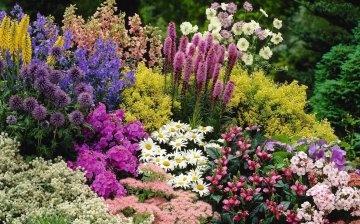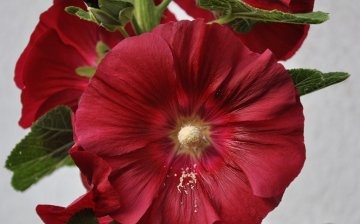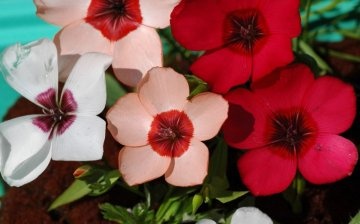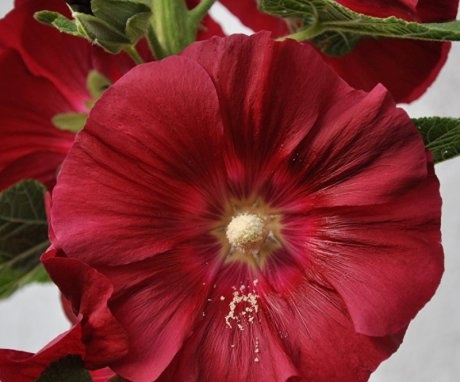Perennials for summer cottages, blooming all summer and most of autumn continuously
Not every owner of a summer cottage has the financial and physical opportunity to plant a garden or flower bed with various plants every year. Most often, weeds grow on the flower beds of summer residents who rarely appear at home.
To prevent this from happening, they practice planting perennial crops at the dacha - herbaceous flowering plants growing in one place for several years in a row. Let's talk about what perennials for a summer residence that bloom all summer can be purchased at any flower shop and planted in the country without hassle.
Advantages and disadvantages of perennials
Perennial flowers have the following benefits:
- it will be time to think about planting new plants no earlier than in 2-3 years;
- perennials bloom longer (May - September, sometimes before the first frost);
- they rarely get sick, they tolerate drought and frost better than other plants;
- not demanding on growing conditions (soil, feeding, pruning - all this is rarely required for perennial plants);
- a variety of varieties (the choice of liliaceae is limited to several hundred species);
- do not lose their decorative properties over time.
If the plants are selected correctly, then the flower bed blooms all summer.
The main disadvantage of planting perennial flowers is the lack of variety. The same flowers bloom in the flowerbed every year.
Classification
All perennial plants are classified according to characteristics such as:
- the term for laying a flower bud (spring of next year when planting in summer or autumn, autumn or summer when planting in spring);
- the duration of cultivation in one place (the transplant is done 1 time in 2, 5, 10-20 years, it all depends on the type of flower);
- wintering ability (they tolerate winter well in the open field or require extraction from the ground and storage in a cool place);
- morphology (sessile, creeping, gigantic, tall, low, medium-sized, dwarf);
- photophilous (love light, prefer shade, tolerate light and shade well);
- requirements for soil moisture (moisture-loving, drought-resistant, growing in conditions of moderate moisture);
- the composition of the soil (not demanding on the content of fertilizers in the soil, they grow only on fertile soils).
Important! Most of the perennial plants grow even without constant care. But the flowering will be richer and more magnificent if the soil under the flower is loosened, fertilized, and the plant itself is sprayed and watered as needed.
The best perennials for summer cottages, blooming all summer
In the country, it is best to plant such plants as:
- phlox;
- astrania;
- mallow;
- evening primrose;
- geleopsis;
- violets;
- kentrantus;
- asters;
- cornflowers;
- large-flowered flax.
The listed flowers will decorate any garden plot, some of them, for example, flax or phlox, can be used to create bouquets.
Phlox
Phlox - a flowering plant belonging to the Sinyukhovye family. At least 40 types of flowers are cultivated, and the same number are wild or rare. Many phlox are perennials, but there are exceptions. So, Drummond's phlox is a one-child. All phloxes have an erect, ascending or creeping stem, they can be bushy, creeping or loose sod (morphological signs). Some plants grow up to 1.5 meters in height. Leaves are green, can be opposite, whole-edged or sessile.The shape of the leaves is lanceolate, ovate with lengthening to the tip, oval-lanceolate.
Flowers are small, tubular and even funnel-shaped, collected in medium-sized inflorescences (up to 90 pieces). A distinctive feature of the plant is the presence of five petals in the flower and the presence of a large number of seeds in the box. One boll of a perennial plant contains over 500 seeds. The flowers have only 1 pistil and 5 stamens. The shade of the bud depends on the species, there are white, pink, lilac, raspberry-red and purple phloxes.
Flowers almost do not need care, you can water it once a month. If it rains, then they don't worry about watering at all. Plants also do not need feeding or forming a bush. Phlox blooms all summer.
Astrantia
A herbaceous flower also called a star flower. They refer it to the umbrella family. Astrania has:
- well developed root system;
- erect shoots, up to 0.9 m high;
- leaves on stems are almost absent, branching is not observed;
- leaves are collected in root rosettes;
- inflorescences are in the shape of an umbrella.
The shade of the buds is pale pink, ruby pink or white. Propagated by seeds. Blooms from May to September.
Important! Astrantia tolerates drought and cold well, it is planted in garden plots not only for beauty, but also to attract bees.
Mallow
Belongs to the Malvovye family. It is distinguished by a long, well-developed branchy rhizome extending more than 1 m into the ground, which allows mallow to easily tolerate drought and grow on soils of varying degrees of fertility.
The flower extends to a height of 1.2 m, the stem is erect, at the base it is covered with hairs-villi, closer to the bud it is glabrous. The leaves are green-gray, large, heart-shaped, covered with villi. The buds are colored burgundy, bright red, pink and white. Mallow blooms in July and blooms until September.
Mallow extremely unpretentious, multiplies by seedlings and seeds, quickly runs wild. Flowering begins in the second year after planting. An annual can be easily transformed into a perennial plant. It is enough to cut off the faded flower at the root in the fall. Sometimes mallow is affected by spider mites and aphids, for preventive planting purposes it is treated with insecticides.
Enotera
It belongs to the Cyprus family (80-150 species), also known as the primrose. It is a rhizome flower grown as an annual, biennial, or perennial. Bushes stretch to a height of 0.3. up to 1.2. m. Stems are straight or creeping, there is a strong pubescence. The leaves are serrated, lobed, simple or pinnately dissected. The flowers are large - 6-8 cm in diameter.
The shade depends on the variety. Evening primrose can be pink, yellow, red, white, or purple. Blooms in June-September. Flowering lasts only 1 day. The buds open in the morning, wither in the evening.
It grows best in well-lit areas of the garden, but partial shade will work as well. The composition of the soil is not demanding, but the plant is not planted on swampy or too wet soils. The plant tolerates drought better than excessive moisture. He needs watering only in severe drought. Top dressing in the form of mineral and organic fertilizers is applied in the spring, but flowering is possible without them.
Important! To prolong flowering from evening primrose bushes, the blooming buds are regularly removed. The plant grows rapidly and this leads to degeneration, once a year it is dug up, large bushes are divided into separate bushes.
Geleopsis
The most beautiful plant, suitable for decorating garden beds and making bouquets. Belongs to the Astrov family. In garden plots, sunflower heleopsis is most often found. It is characterized by branched straight stems extending to a height of 1.6 m. The leaves are elongated with jagged edges. Each stem has 1 to 3-4 double, semi-double or simple buds, reaching 9 cm in diameter. The color is mostly yellow or orange.
They are grown from seeds, but in some cases they are used for planting and seedlings. They are planted in the soil at the end of May-June. When planting, compost is introduced into the soil, drained. These plants thrive best in loamy, well-lit areas. Water as needed, but not often. Bushes are tied to a trellis or tied together. This prevents them from being damaged by rain and wind.
In order for the plant to retain its decorative properties longer, pinch its tops. If the plant has grown and began to displace other flowers from the flower bed, it is dug up, the bush is divided, the stems with the strongest roots are planted back, the rest is thrown away.
Violet graceful
Low-growing perennial (10-20 cm). stems ascending, large, with large denticles. Flowers reach 3-4 cm in diameter, have a lilac, yellow or lilac-purple color. Bloom all spring, summer and autumn, if it is warm.
In the garden, the plant prefers a sunny or slightly shaded plot of land, nutritious, well-drained soil. Does not tolerate excessive moisture, the roots rot, the violet disappears. There are several varieties of violets:
- violet Nelson with dark purple, almost black buds;
- Moonlight with bright yellow flowers;
- Major with large purple buds, in the center of which are yellow eyes.
Graceful violets are most often decorated with alpine slides.
Kentrantus
Also known as red valerian. Kentrantus is a beautiful plant with erect stems and small flowers, collected in large inflorescences. The root system is superficial, the plant is bushy, grows 0.5-07 m wide, some stems reach a height of 0.9 m. The leaves are gray or dark green, completely covering the stem. The shade of the flowers is predominantly red with varying variations.
Centrantus blooms twice a year - at the beginning and at the end of summer. To plant it on purpose, if the centrantus was already on the site, it will not have to be, self-seeding occurs. To decorate flower beds, they use such varieties as:
- Ruber;
- Narrow-leaved (suitable for an alpine slide);
- Long-flowered;
- Valerian-shaped.
Seeds are sown in spring or autumn. Grown in sunny areas of the garden. Lime is added to the soil before planting, it is well drained. They are fed with nitrogen, potassium and phosphorus. One top dressing over the summer is enough.
Asters
It is included in the family Asteraceae or Asteraceae (200-500 species). It is a beautiful plant with large flowers of various colors (red, pink, lilac, white), and erect stems.
Perennial asters are propagated by cuttings or dividing a bush, annual seeds. Sowing is carried out in spring or autumn. If seedlings are planted, then they are sown at the end of March. Aster blooms all summer and most of autumn, prefers loamy soil, illuminated or shaded areas of the garden. They are fed 3 times per season - immediately after planting (after 7 days), before flowering and after it starts. Water in moderation. Aster is affected by powdery mildew and spider mites, if necessary, they are treated with insecticides.
Cornflowers
Herbaceous plant with a recumbent or erect stem (1.2 m in height). Inflorescences are large, collected in baskets. The root system is powerful, branched. The following types of cornflowers are grown on garden plots:
- Blue;
- Mountain;
- White;
- Yellow;
- Large-headed;
- Lugovoi;
- Field;
- Spreading.
In one place it grows up to 7 years in a row It is planted in the spring. Propagated by cuttings or seeds. A distance of 0.4-0.5 meters is maintained between individual cuttings. Cornflowers grow best in areas of the soil exposed to the sun's rays; they are indifferent to the composition of the soil. Water as needed. Top dressing is almost never applied.
Large-flowered flax
Part of the Flax family. Grows up to 0.6 m in height. The stem is thin, branched with narrow small leaves. The flowers are large, up to 5 cm in diameter.They can be white, blue, purple and pink. Blooms in June and continues to bloom until September.
It grows wherever it is planted, but blooms poorly in a swampy area. Propagated by seeds. They are sown in May after the establishment of warm sunny weather. Before planting, the seeds are treated with fungicides.
Criterias of choice
Before planting plants on a flower bed, they determine what kind of appearance the site should have, find out the composition of the soils, the degree of illumination, which flowers are already growing in the flower bed, which ones are planned to be planted. Depending on the degree of illumination, the quality of the land, the presence of drafts, frequent rains in the region, the purpose of planting, tall, medium-sized, low-growing or curly perennials are chosen for planting.
Tall, medium, short, curly
Perennial plants are distinguished by a variety of choices. Each grower will find a suitable bush or grass for himself. But there are also certain landing rules. So, it is advisable to plant perennial tall, medium-sized or climbing plants near the fence. low-growing perennials are planted on alpine bitterness, and in the garden there are plants that, by their size, will not drown out the varieties already growing there.
Large-flowered flax and heleopsis will look beautiful near the fence (tall), violet and cornflower will decorate an alpine hill (undersized), and aster and red valerian will decorate any flower bed (medium-sized).
Shade tolerant
If the site is not sufficiently lit, they think about finding shade-tolerant plants that will delight the eye with flowering even with a lack of light. These include:
- Fragrant violet;
- Medunitsa;
- Creeping tenacious;
- Liliaceae;
- Lady's slipper;
- Hazel grouse;
- Rhododendrons;
- Hydrangeas;
- Fuchsia.
Among the named plants, there are both undersized and tall, climbing and creeping.
Selection by region
Perennial plants for the most part love the sun and warmth; it is not at all easy to grow them in the northern part of the country. So, such a beautiful flower as astilba cannot be found in central Russia, but a violet or acidander in the north. Asters and cornflowers tolerate light frosts well, so they can be grown in the northern regions as well.
The choice of a perennial is associated with the duration of its growth and flowering. So, if a plant blooms closer to autumn, then in the north it is rarely planted, because due to frosts, which usually hit already in September, it simply does not have time to develop as it should. Plants blooming in July-August are suitable for the northern regions. Most of the listed plants grow in the south. The choice of a flower for the middle lane depends on weather conditions. It should be borne in mind that some plants growing in the north and in the middle lane have to be dug up for the winter (usually all bulbous).
Perennials are a real salvation for a gardener who does not have time to plant plants annually. They are unpretentious in care, grow on any soil and under almost any conditions. Asters, hazel grouses, evening primrose seldom need to be watered or fed. Most of the perennial plants grow like weeds, are sown by self-sowing.
Related videos:












Very beautiful flower beds are obtained with perennial flowers and minimal care is required, mainly weeding and watering. Instead of these flowers, you can plant several rose bushes, they also bloom all summer, because they have three blooms.
In the shade-tolerant, they forgot astilba (well, since the hazel grouse was mentioned, it doesn't bloom all summer long) and aquilegia. By the way, here - perennial lobelia, it still feels better in the shade and partial shade.